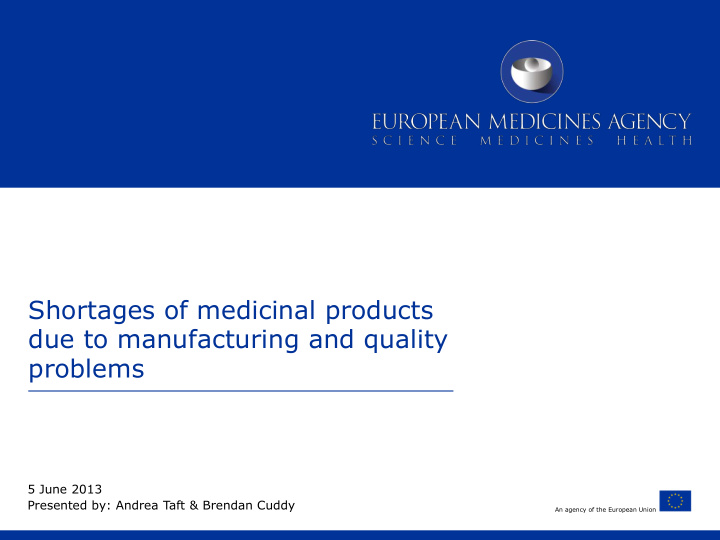



Shortages of medicinal products due to manufacturing and quality problems 5 June 2013 Presented by: Andrea Taft & Brendan Cuddy An agency of the European Union
Overview • Introduction • Consequences of drug shortages • Actions taken by the EU Regulatory Network and the CHMP • Next steps • Your contribution 1
Drug shortage – definition(?) American Society of Health-System Pharmacists (ASHP): “A supply issue that affects how the pharmacy prepares or dispenses a drug product or influences patient care when prescribers must use an alternative agent ” Am J Health-Syst Pharm 2009;66:1399-1406. FDA: “A situation in which the total supply of all clinically interchangeable versions of an FDA-regulated drug is inadequate to meet the current or projected demand at the user level. In general - focuse on shortages of medically necessary products that have a significant effect on public health ” FDA, Manual of Policies and Procedures, 6003.1. September 26, 2006, version Feb2012 2
Public awareness 3
Reasons/Causes • Manufacturing failure • Closure/planned maintenance of the manufacturing site • Quality defect (product, packaging) • Raw material unavailability • GMP con-compliance at a manufacturing site • Contamination • Unexpected increase in demand in clinical practise due to a supply shortage of a different medicinal product • Drug recall, discontinuation • Natural disaster, fire… 4
Experience so far… • Permanent • Single drug • Temporary • Multi drug • Planned • Serious condition • Sudden • Rare indication • Local/national • Lack of alternatives • Pan-European Often start as acute or national and develops into long-lasting and/or worldwide 5
Consequences of drug shortages • Failure to treat adequately • Delay/denial of treatment to patients • Exposure to defective product • Increased risk of medical errors • Change in prescribing • Restricted use • Use of alternative product – Availability – Interchange (efficacy, safety, administration route, etc.) – Adverse profile 6
Communication • Targeted for various stakeholders • Timely • Corrective measures • Format: – DHPC + PhV communication plan – CHMP dedicated press release – Q&A – Educational material • Consultation and feedback received from patients and healthcare professionals (Fabrazyme, Increlex, Depocyte, etc.) 7
Importance of the Supply Chain • Supply chain is frequently a complex path • Every stage in the process there is an opportunity for a problem to arise • Supply chain disruption due to manufacturing/GMP and quality problems also have as an economic impact due to increased costs e.g recalls and decreased public confidence in the organisation = -7% drop in shareholder value.
EU Legal Framework • EU legislation currently requires mandatory pre-notification by; • MAHs of disruption of supply in the case of permanent or temporary cessations (Financial penalties possible for centrally authorised products) • Manufacturers of medicines in the case of any defect that could lead to an abnormal restriction in supply. • Distributors and MAH’s - Continued availability of medicinal products for human use : Article 81 of Directive 2001/83 (Financial penalties may be possible depending on national legislation) • .
EMA Actions • Discussions at CHMP and CMD(h) • Discussions at HMA • Regulatory authority Workshop in September 2012 • GMDP IWG Interested parties discussions in November 2012 • In November 2012 EMA published a reflection paper and implementation plan;
Implementation Plan • Develop common understanding of “essential” medicine/develop decision tree/clarify national input into EU advice/communication • Explore if crisis situations resulting from product shortages should be addressed in context of EU Incident Management Plan (IMP) • Develop international co-operation to foster sharing of information
Implementation Plan • Raise awareness of the impact of product shortages and stimulate industry reaction and improvement in Business Continuity Planning • Facilitate Benefit / Risk evaluation • Promote better and proactive risk management by Marketing Authorisation Holders • Investigate how to measure the impact of drug shortage in patients
What else do EU authorities do to prevent shortages? Primary • Expedited variations • Waived inspections • Rational risk-benefit decision making more frequently with consultation Secondary • Transparency about GMP status of manufacturers via EudraGMP
What can industry do? • Shift focus from reactive to proactive risk management and more explicitly assess supply chains and transport risks as part of procurement and contract management and corporate governance processes. • Improve pre- and post-incident communication on disruptions. • Industry associations : develop and share methodologies for assessment, information sharing, communication. • Marketing authorisation holders : develop supply chain RESILIENCE
What can healthcare providers and patients do? Assist with the communication Reducing the demand • Identifying alternatives using clinical pharmacology strategies Rational reallocation • Using alternatives that are in greater supply • Sharing information to assist in identifying priority patients for allocation Expert meetings and consultation Clinical/treatment feedback Follow up monitoring 15
Recommend
More recommend